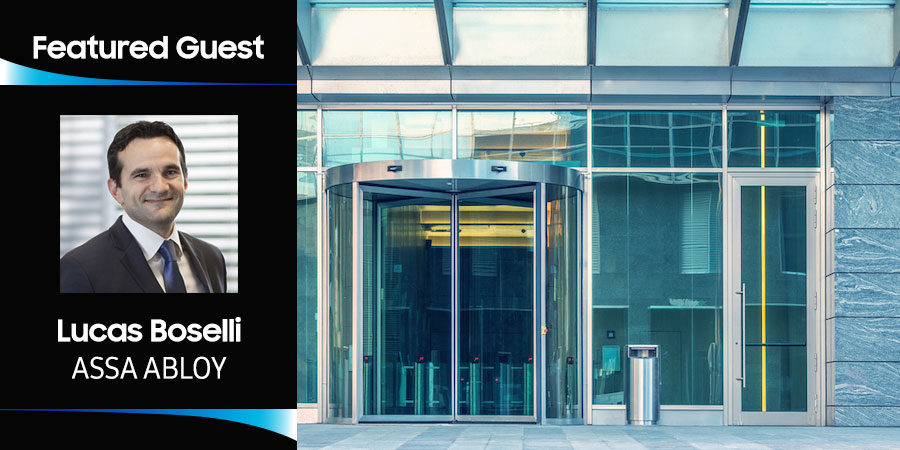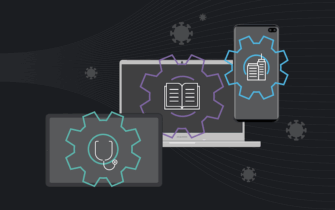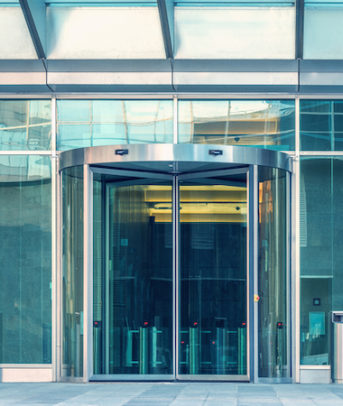Editor’s Note: This conversation is part of our ongoing “Future State Of” series. It has been edited for length and clarity.
Video meetings and commutes from the kitchen sink to the kitchen table have been hallmarks of many people’s workdays the past few months, as companies worldwide shifted to remote work due to COVID-19. And though technology has made remote work more manageable than anticipated, many companies plan to bring employees back to the office soon. In fact, 67 percent have already resumed or expect to resume operations by the end of the summer.
Whether an office reopens in the coming months or waits until 2021, one factor is consistent: facilities will have to change and evolve in response to the pandemic. Even when a treatment or vaccine is found, the effects of the pandemic are expected to be profound and long-term when it comes to our expectations for workspaces moving forward.
Taher Behbehani, GM and SVP of Samsung B2B, sits down with Lucas Boselli, EVP and Head of Americas at ASSA ABLOY, a global leader in access control solutions, to discuss how facilities will have to adapt in the next normal and what we can expect in our future workplace.
Taher Behbehani: Hi Lucas, thanks for speaking with me today. Over the past few months, we’ve seen workforces move to full-time remote work. But as the economy begins to reopen, companies are ready to bring their employees back to the office. What do facility and business managers need to be thinking about and doing to prepare?
Lucas Boselli: Thanks, Taher. It’s great to speak with you. There’s no question that COVID-19 has significantly disrupted our world. The spaces where we work and gather will require a creative reimagining in order to reopen safely.
Unfortunately, there are still many unknowns around COVID-19, which can be challenging when trying to determine the steps needed to make a facility safer. When we work with customers, we like to start by talking through the things we do know about COVID-19.
First, at ASSA ABLOY, we’re access control experts, and our customers are facility experts managing the complexity of security and safety across multiple vertical markets. It’s important to recognize the scope of our expertise and listen to the public health experts when thinking through solutions. We need to take recommendations from the health experts and merge that with our knowledge of access control and facilities to figure out how to make workspaces safer.
Second, we know that reducing touchpoints and enabling social distancing are two approaches that help reduce germ spread — not only in the case of COVID-19, but in other illnesses too. We’re keeping these two concepts at the forefront of our strategy as we analyze which solutions will reduce touchpoints and allow for social distancing without hindering the security and functionality of a space.
Finally, it’s important to recognize that these changes aren’t short-term. Even when the pandemic passes, I think being proactive about public health will continue to be a top priority. This means the quick changes facilities make today in response to COVID-19 should have relevance for the future, too.
TB: Those are all great points, especially your comment about listening to the experts. It’s so important to recognize our own limits and collaborate with others to deliver the best possible outcome. We’ve taken that same approach at Samsung and worked with partners who have expertise we don’t when developing new solutions in response to COVID-19. Speaking of solutions, tell me more about the specific solutions or changes you think we’ll see in workplaces moving forward.
LB: There’s a lot of conversation happening right now about the “new workplace” with very futuristic ideas about how offices will be after the pandemic. Some of those ideas are certainly possible, but I think a lot of the changes will be much more straightforward.
What’s particularly interesting is that the idea of seamless and frictionless access, both at home and at work, has been around us for a while now. Think about high-rise commercial offices — they often have touchless access control systems at the entrance and push or wave access to open doors in other parts of the building. At home, we can even give access rights to visitors if we are not available to let them in ourselves. The understanding and interest in making the entire process more integrated and seamless exists and there are already early signs that these concepts are expanding to new verticals, such as education.
In addition, there are new challenges that we need to think about in this new workspace. Delivery is an essential part of doing business and is, traditionally, a high-touch process. One of our companies, Luxer One, created a contactless package delivery system that increases the efficiency of the delivery companies while improving both the tenant and end-user experience.
Moving forward, facilities are going to be more proactive in providing solutions that make this seamless experience easier and at ASSA ABLOY, our priority is helping make it possible.
TB: We’ve seen how important technology has been in making remote work effective. What role will technology play in making the return to office safe? What kinds of technologies should facility and business managers be thinking about when evolving their spaces for the next normal?
LB: Electronic and digital access control solutions have grown in popularity in recent years and can create opportunities for facilities to expand their capabilities. For example, a Wi-Fi powered access control system that enables keyless, hands-free entry and exit throughout a facility can also capture data about who is coming in and out of a space, which has endless relevance for protecting public health. In a positive COVID case scenario there is the ability to perform contact tracing if the user desires to do so.
At CES earlier this year, ASSA ABLOY and Samsung, as part of the FiRa Consortium, demonstrated a door that detects your movement toward it via your smartphone, authenticates you and then automatically opens the door as you approach it — a truly touchless experience.
TB: I love hearing about how technology can be applied to help solve these challenges. At Samsung, we’re working with partners on a solution that involves our wearables and has great applicability for workplaces. It can monitor the distance between people and alerts them if they’re closer than six feet.
LB: That’s fantastic. There’s no question technology is going to play a bigger role in our day-to-day moving forward.
TB: Agreed. On that note, tell me what you think the future workplace will look like. You talked earlier about hands-free solutions, but what about five or 10 years from now. What other changes can we expect to see in the workplace?
LB: Mobile is going to become even more prominent and reach a point where it’s not just used on-the-go. I mentioned using mobile devices as credentials in place of keys, but that’s just the beginning. I think we’ll see the functionality and purpose of mobile continue to expand, and these devices will be used in other ways throughout our days. The new trend of remote working, for example, creates a lot of opportunity to enhance access control via a mobile device. Employees could reserve a workstation through an app on their phone; that same app would give them credentials to enter the office, unlock their assigned workstation and access their smart locker where they could store their personal items.
TB: That’s really interesting, and I completely agree that the role of mobile is only going to grow. We’re seeing it with remote work and our DeX software, which extends a smartphone or tablet into a desktop computing experience.
Before we wrap up, is there anything we haven’t touched on that you feel is important?
LB: I think in some ways, the pandemic has accelerated what was inevitable in terms of facilities and access control. Implementing automated and digital solutions was always part of the forecast, but the pandemic has demanded facilities evolve faster and reorient how they think about applying some of these solutions. It can be overwhelming, but it’s helpful to keep in mind that the investments made in these solutions today is not for nothing. They’re the foundation for the future of access control and will continue delivering value tomorrow and beyond. What we’re doing today to solve the pandemic challenges has to have purpose and scalability to support an office in the future.
TB: That’s great advice. Thank you again for speaking with me, Lucas.
LB: Thank you, Taher. It’s been my pleasure.
Learn how social distancing management solutions can help your business return to work with confidence. And keep up to date with the latest announcements and insights by following Taher Behbehani on Twitter.








